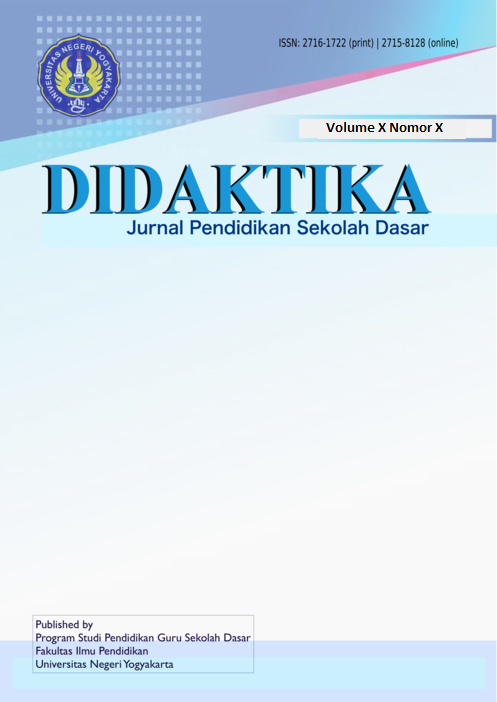Representasi Bullying di Sekolah Dasar: Studi Kasus di Sekolah Model dan Pembina
DOI:
https://doi.org/10.21831/didaktika.v3i1.31607Abstract
The purpose of this study is to represent bullying in one of the Model elementary schools in Sragen. This research adopts a qualitative approach, which is a case study, to reach the goal. The research subjects are all teachers and students of Model Elementary Schools. Data collected by observation and in-depth interviews. The results of this study describe (1) the impact shown by victims of both female and male gender and audience reactions; (2) forms of bullying; 3) handling bullying. Detailed results and discussion can be seen in this article.
Keywords: representation, bullying, preventive, elementary school
References
Amini, Y. S. J. (2008). Mengatasi Kekerasan di Sekolah dan Lingkungan Sekitar Anak. Jakarta: PT Grasindo.
Astuti, P. R. (2008). Meredam Bullying: 3 cara efektif menanggulangi kekerasan pada anak. Jakarta: Grasindo.
Coloroso, B. (2007). Stop Bullying, Jakarta: PT. Ikrar Mandiri Abadi.
Cowie, H., & Jennifer, D. (2009). Penanganan Kekerasan di Sekolah: Pendekatan Lingkup Sekolah untuk Mencapai Praktik Terbaik. Diterjemahkan Oleh: Gyani, U. Jakarta: Indeks.
Firdaus, F. M. (2019). Upaya Mengatasi Bullying di Sekolah Dasar dengan Mensinergikan Program Sekolah dan Parenting Program melalui Whole-School Approach. DIDAKTIKA: Jurnal Pendidikan Sekolah Dasar, 2(2), 49–60.
Glew, G. M., Fan, M.-Y., Katon, W., Rivara, F. P., & Kernic, M. A. (2005). Bullying, psychosocial adjustment, and academic performance in elementary school. Archives of Pediatrics & Adolescent Medicine, 159(11), 1026–1031.
Hidayah, N. N., & Prananto, I. W. (2019). Efektifitas Pembelajaran Learning Cycle 5E Terhadap Prestasi Belajar Matematika. DIDAKTIKA: Jurnal Pendidikan Sekolah Dasar, 2(2), 81–86.
Januarko, W. (2014). Studi tentang penanganan korban bullying pada siswa SMP se-kecamatan Trawas. Jurnal BK UNESA, 4(2).
Junita, J., Mamesah, M., & Hidayat, D. R. (2015). Kondisi Emosi Pelaku Bullying. INSIGHT: Jurnal Bimbingan Konseling, 4(2), 57–63.
Marsudi, S. (2003). Layanan Bimbingan Konseling Di Sekolah. Surakarta: Muhammadiyah University Press.
Mishna, F., Saini, M., & Solomon, S. (2009). Ongoing and online: Children and youth's perceptions of cyber bullying. Children and Youth Services Review, 31(12), 1222–1228.
Moleong, L. J. (2019). Metodologi penelitian kualitatif.
Murphy, M., & Fleming, T. (2010). Habermas, critical theory and education. Routledge.
Oluremi, O. F. (2012). Creating a friendly school learning environment for Nigerian children. European Scientific Journal, 8(8), 138–147.
Rudi, T. (2010). Informasi Perihal Bullying. Indonesian Anti Bullying.
Samino, S. M. (2011). Layanan Bimbingan Belajar. Surakarta: Fairuz Media.
Smith, P. K., & Brain, P. (2000). Bullying in schools: Lessons from two decades of research. Aggressive Behavior: Official Journal of the International Society for Research on Aggression, 26(1), 1–9.
Sugiyono, M. P. P. (2007). Pendekatan Kuantitatif. Kualitatif, Dan R&D, Bandung: Alfabeta.
Weshah, H., Al-Faori, O., & Sakal, R. (2012). Child-friendly school initiative in Jordan a sharing experience. College Student Journal, 46(4), 699–715.
Wiyani, N. A. (2012). Save our children from school bullying. Jogjakarta: Ar-Ruzz Media.
Downloads
Published
How to Cite
Issue
Section
Citation Check
License
- Authors retain copyright and grant the journal right of first publication with the work simultaneously licensed under a Creative Commons Attribution License that allows others to share the work with an acknowledgement of the work's authorship and initial publication in this journal.
- Authors are able to enter into separate, additional contractual arrangements for the non-exclusive distribution of the journal's published version of the work (e.g., post it to an institutional repository or publish it in a book), with an acknowledgement of its initial publication in this journal.
- Authors are permitted and encouraged to post their work online (e.g., in institutional repositories or on their website) prior to and during the submission process, as it can lead to productive exchanges, as well as earlier and greater citation of published work.






